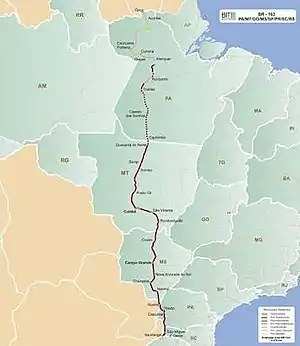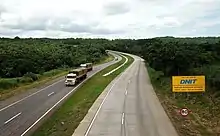BR-163 (Brazil highway)
BR-163 is a highway in Brazil, going from Tenente Portela, in the state of Rio Grande do Sul, to Santarém, Pará, on 3579 kilometers (the stretch between Santarem and Brazil-Suriname border is only a project, the highway would have a total size of 4,426.7 km if it were all implemented).[1]. It was proposed to pave the road in its entirety part of the Avança Brasil project, which in 2007 was replaced by the Programa de Aceleração do Crescimento. A 51 km long stretch of the highway was finally paved in 2019 in the state of Pará in a cooperation between the Bolsonaro government and the Brazilian army engineering battalion, until the city of Miritituba, leaving only a small part of the highway to be paved on the other side of the Amazon River.[2][3]
 | |
|---|---|
 | |
| Route information | |
| Length | 4,426.7 km (2,750.6 mi) |
| Major junctions | |
| North end | Oriximiná, Pará |
| South end | Tenente Portela, Rio Grande do Sul |
| Location | |
| Country | Brazil |
| Highway system | |
Since the construction in 1976, most of the highway was not paved in the state of Pará, with most of the asphalt existing only from the urban area of Santarém to the city of Rurópolis. Because of this, the stretches of beaten ground turned into big puddles in times of rain, hindering the flow of agricultural crops from the region. It's a highway that integrates the South with the Midwest and North of Brazil. It's of fundamental importance for the flow of production from Pará and north of the Midwest Region of Brazil. The connection between the Mato Grosso-Pará border and the ports in the Santarém area, on the Amazon River, is about 1000 km apart, so the middle and north of Mato Grosso will have advantages in exporting its enormous agricultural and livestock production through this path, instead of the Port of Santos, which is 2000 km from this area.[4]
In March 2016, 117 km of highway was duplicated between Rondonópolis and the border with the state of Mato Grosso do Sul.[5]
In the state of Mato Grosso, the Federal Government has been doubling the road between the cities of Cuiabá and Rondonópolis, a stretch of 191 km. At the end of 2018, the duplication of the section between the cities of Cuiabá and Jaciara, about 100 kilometers, was inaugurated. As of March 2019, there were already 151 duplicate km, and the forecast for completion of work was 2020.[6][7]
In Mato Grosso do Sul, the highway has a fundamental role in commerce, tourism and mainly in the transport logistics of the agribusiness, as it's the main export corridor in the state to reach the ports of the states of São Paulo, Paraná and Santa Catarina. The highway is extremely important for states like Mato Grosso, the largest producer of grains in the country (the state is the largest producer of soybeans, corn, cotton, the third largest producer of beans, and the sixth largest producer of sugar cane). of the country), in addition to having the largest herd of cattle in the country, more than 30 million head of cattle, which represents almost 14% of the national production alone. [8][9][10][11][12][13][14][15][16][17]
In the state of Paraná the highway passes through important cities like Cascavel and Toledo. In 2020 there was a 74 km stretch between Cascavel and Marmelândia being duplicated.[18]
In the state of Santa Catarina the highway gains the status of a road center for transporting agricultural production, most notably from São Miguel do Oeste.
Gallery
 BR-163 / 364, duplicate section between Cuiabá and Rondonópolis
BR-163 / 364, duplicate section between Cuiabá and Rondonópolis BR-163 / 364, duplicate section between Cuiabá and Rondonópolis
BR-163 / 364, duplicate section between Cuiabá and Rondonópolis BR-163, duplicate stretch in Mato Grosso do Sul
BR-163, duplicate stretch in Mato Grosso do Sul BR-163, duplicate stretch in Mato Grosso do Sul
BR-163, duplicate stretch in Mato Grosso do Sul
References
- Rodovias Longitudinais
- http://agenciabrasil.ebc.com.br/geral/noticia/2019-11/governo-conclui-obras-de-pavimentacao-da-br-163-no-para
- Após décadas, Exército conclui pavimentação da BR-163, aberta em 1976
- "Força-tarefa vai garantir escoamento de grãos pela BR-163". Archived from the original on 6 February 2019. Retrieved 5 August 2020.
- Dois anos após concessão, trecho da BR-163 em MT é duplicado
- "Duplicação entre Jaciara e Cuiabá será inaugurada". Archived from the original on 21 August 2021. Retrieved 12 March 2021.
- Obra na via entre Cuiabá e Rondonópolis deve ser concluída em meados de 2020
- IBGE prevê safra recorde de grãos em 2020
- Quatro estados concentram quase 70% da produção de grãos do país
- Qualidade do algodão de MT é destaque em congresso nacional
- MT segue como líder isolado na produção de algodão e safra sobe para 65% em 2017/18
- Goiás é o segundo maior produtor de cana-de-açúcar do País
- ACOMPANHAMENTO DA SAFRA BRASILEIRA DE CANA DE AÇÚCAR MAIO 2019
- Mato Grosso tem o maior rebanho bovino do país e representa 13,8% da produção nacional
- Rebanho bovino de Mato Grosso chega a 30.3 milhões de cabeças
- "Alencar destaca importância da rodovia BR-158". Archived from the original on 8 July 2020. Retrieved 12 March 2021.
- BR-158 tem importância nacional, diz Pagot
- Dnit investe R$ 580 milhões na duplicação na BR-163, no Paraná